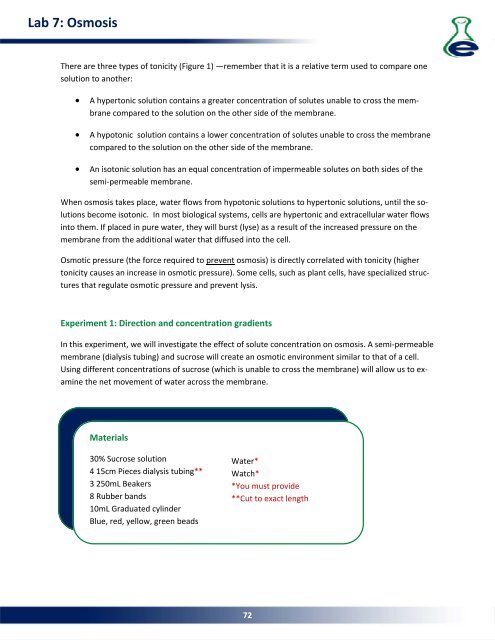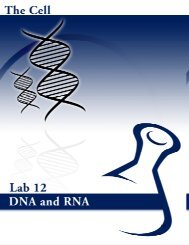Lab 15: Population Genetics - eScience Labs
Lab 15: Population Genetics - eScience Labs
Lab 15: Population Genetics - eScience Labs
You also want an ePaper? Increase the reach of your titles
YUMPU automatically turns print PDFs into web optimized ePapers that Google loves.
<strong>Lab</strong> 7: Osmosis<br />
There are three types of tonicity (Figure 1) —remember that it is a relative term used to compare one<br />
solution to another:<br />
<br />
<br />
<br />
A hypertonic solution contains a greater concentration of solutes unable to cross the membrane<br />
compared to the solution on the other side of the membrane.<br />
A hypotonic solution contains a lower concentration of solutes unable to cross the membrane<br />
compared to the solution on the other side of the membrane.<br />
An isotonic solution has an equal concentration of impermeable solutes on both sides of the<br />
semi‐permeable membrane.<br />
When osmosis takes place, water flows from hypotonic solutions to hypertonic solutions, until the solutions<br />
become isotonic. In most biological systems, cells are hypertonic and extracellular water flows<br />
into them. If placed in pure water, they will burst (lyse) as a result of the increased pressure on the<br />
membrane from the additional water that diffused into the cell.<br />
Osmotic pressure (the force required to prevent osmosis) is directly correlated with tonicity (higher<br />
tonicity causes an increase in osmotic pressure). Some cells, such as plant cells, have specialized structures<br />
that regulate osmotic pressure and prevent lysis.<br />
Experiment 1: Direction and concentration gradients<br />
In this experiment, we will investigate the effect of solute concentration on osmosis. A semi‐permeable<br />
membrane (dialysis tubing) and sucrose will create an osmotic environment similar to that of a cell.<br />
Using different concentrations of sucrose (which is unable to cross the membrane) will allow us to examine<br />
the net movement of water across the membrane.<br />
Materials<br />
30% Sucrose solution<br />
4 <strong>15</strong>cm Pieces dialysis tubing**<br />
3 250mL Beakers<br />
8 Rubber bands<br />
10mL Graduated cylinder<br />
Blue, red, yellow, green beads<br />
Concepts to explore:<br />
Water*<br />
Watch*<br />
*You must provide<br />
**Cut to exact length<br />
72
















